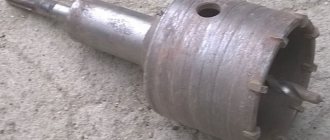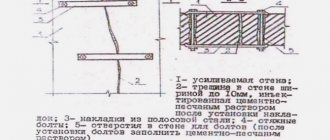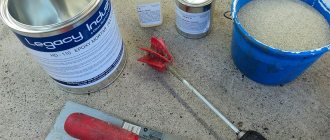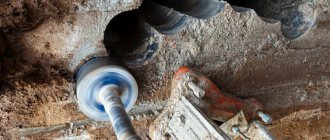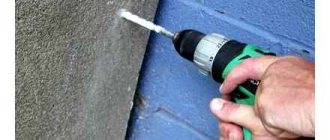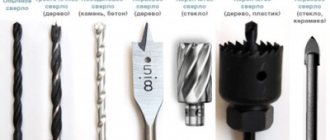Choosing a power tool for drilling holes in masonry
The main power tool that can be used to drill into a brick wall is a hammer drill or impact drill. A conventional household drill has less power and, according to its technical characteristics, is not designed for long-term operation with high loads that arise when drilling large-diameter holes.
If a construction hammer is not available, the household drill used must have a switch for impact drilling, a power of at least 600 W, the ability to smoothly regulate the speed; a reverse mode may be useful during operation.
Preparing to drill a brick wall
Before you get to work and start drilling into the wall, you need to make sure that there are no obstacles in the wall in the form of electrical wiring or water pipes. A metal detector can help with this: by pointing the device at the wall, you can detect an obstacle in time and thereby determine a safe point for drilling.
To correctly drill through any brick wall, the first step is to make a mark on the wall. For marking, a tool such as a center punch is used, which is a pointed steel rod. A center punch is used to drill a small hole in the wall, making it possible to fix the drill in a level position.
Dust-free drilling
If drilling is being done in an already renovated area, you always want to avoid contamination or damage to the finish. This will not happen if you attach a shelf made of the same material to the bottom of your stencil. Your wallpaper or paint will be protected, and dust from drilling will linger on this shelf.
Note! You can use a regular tetra pack (milk carton) by cutting it in half. On one side, you need to cut a little more with scissors so that the paper does not interfere with the drill.
And a few more words about how to make a hole in a large brick wall or create a small niche.
In home repairs, a Pobedit drill can easily cope with this task:
- Mark the outline of the hole on the wall.
- Perform several drillings along the marked line in 10 mm increments.
- Use a hammer and chisel to remove any unwanted material.
If you need to go to a greater depth, and the length of the drill does not allow it, do the work in two or more approaches.
How to drill without dust
The need to create holes also arises in a finished room with finishing. In this case, you don’t want to spoil it or pollute it again. You can avoid these consequences in a simple way: attach a small shelf to the bottom of the stencil, which can be made from scraps. In this case, the finish (in the form of wallpaper, paint or anything else) will not be damaged, and all the dust will settle on the shelf made.
A cardboard milk or juice bag will work for this purpose. It needs to be cut into two parts. You will get a small trough. One of the long walls should be made higher than the other. This is necessary so that it does not come into contact with the drill.
Construction of houses
Quite often there is a need to drill holes in brick walls. However, the technology for carrying out this process directly depends on the drilling location and the size of the required hole. Let's look at how to drill a hole in a brick wall below.
Table of contents:
- Drilling holes in a brick wall: technology and methods
- Technology for punching holes in a brick wall
- Instructions for making a hole in a brick wall
Drilling holes in a brick wall: technology and methods
Most often, drilling holes in brick walls is associated with the improvement of a house or apartment whose walls are made of brick. In order to build an internal outlet or hang shelves, mirrors, or a TV, you need to make holes in the wall.
However, for installing small items such as photo frames or small paintings, a small nail is sufficient. In this case, there is no need to drill the wall.
In order to drill a wall, all you need is a modern electric tool, such as an electric drill, and the skills to work with it. With the help of a special conductor, it is possible to get rid of dust generated during drilling.
In order to drill into a wall made of brick or concrete, a hammer drill is most often used. However, the cost of this tool is very high, and most often, in its absence, an impact drill is used.
Answers from forum users and experts to the question: How to drill brick?
You can drill with a conventional drill using Pobedit carbide brazing on the drill. You can also try with a hammer drill (if you have one), but it will make larger holes, so you should take a narrow drill. You can also use a tile drill. To avoid having to constantly remove the drill from the chuck to remove dust, take a longer drill.
Was the information useful?
Answer or clarify the question
Subscribe to a forum topic
Popular questions
The saw does not maintain idle speed and does not pick up speed; it runs almost uniformly
How to glue tiles to a clay wall?
How to organize the production of foam blocks?
I have a terrible view of the wooden house from the inside. Therefore, I plan to do the interior cladding of the house. Tell me what it is.
I want to cover the imitation pine timber on the façade with materials from the company Biofa
first antiseptic primer, glaze 2 layers, oil. The seller suggests tinting the oil as this is the last layer and it is the one that should be tinted, so they say. question.
What is the cost of building a one-story house made of timber?
I decided to build a one-story house from timber, but I’m just starting to collect money for this construction. Tell me, how much do I need to collect?
Interior of a chic white kitchen
If you have a huge kitchen space, then this is what it should look like. Don’t be intimidated by the abundance of white: it makes this kitchen look chic and fresh. White.
Good to know
Drilling technology
There are three ways to drill a hole in a brick wall: manual, electromechanical and automatic.
However, before starting work, it is necessary to study the location of the electrical wiring, since accidentally touching the wiring line will not only damage it, but can also electrocute a person. Most often, electrical wiring is located vertically or diagonally relative to sockets and switches. If you have any doubts, you should use a special device to detect hidden wiring. A portable metal detector will help detect aluminum or copper wire located no deeper than 1 cm.
A portable metal detector will help detect hidden communications
Hand Drilling Technology
In the absence of an electric tool, drilling holes can be done using a bolt. To do this, locations are pre-marked by drilling with a punch. After this, the bolt, which is applied to the wall at an angle of 90 degrees, is struck with a hammer. Every three blows, the bolt is rotated, and the remaining bricks are removed from the pipe. Thus, the hole is knocked out until it reaches the required depth.
Electromechanical process
Mechanical drilling is performed with a hammer drill or hammer drill, the process is the same.
First you need to decide on the type (through, not through), depth and diameter of the hole. This is necessary for a properly selected drill or drill. If you have difficulty maintaining the same distance between the holes, you can use a template. The stencil is made from plywood, chipboard, plastic and other available materials. To use it, you need to secure the sandpaper on one side with double-sided tape or glue, then lean it against the wall and drill.
After the type and diameter of the future hole has been determined, markings should be made with a core. The drilling process will be easier if it is done in the seam between the bricks. Notches with a core are made in order to fix the drill and facilitate its entry. When drilling with a drill, the tool must be held perpendicular to the wall, pressing gently on it so as not to break the drill or drill. Periodically, the drill must be taken out for cooling in a container with cold water.
If it is necessary to drill a hole with a diameter greater than 18 cm, a hammer drill with diamond bits is used. If these are not available, you can use Victory drills of regular diameter. For this:
- The location of the future hole is outlined, and its outline is outlined with a pencil.
- Drilling is done along the outside of the line; the number of holes depends on the diameter of the contour. The diameter of the drill itself should be 0.8-1.0 cm, the pitch of the holes along the contour should be 1.0 cm. To do the job more accurately, you can use drills with an even smaller diameter, but then the process will take longer.
- Using a chisel and hammer, a sample is made from the drilled contour.
If you need to drill through a thick wall, you can do this in two stages: first, perform the drilling process as described above on one side of the wall. Then, the center of the resulting hole is drilled through. After this, the required diameter is marked on the other side of the wall around the intended through center, and the process is repeated.
Automatic process
Diamond drilling is carried out using professional, expensive equipment. In this case, it is desirable to have special skills and qualifications. With the help of such a tool, the drilling process is fast, accurate, almost silent, and can be done at different angles to a depth of up to 40 cm, resulting in a smooth hole, without chips or cracks. This method does not create a lot of dust and dirt, since the tool is equipped with an attachment to cool the drill and wash away the dust.
Forming a hole for a pipe using construction components
In addition to the tool, you need to be able to choose the right nozzle. Usually for one tool there are several sets of drills and attachments for different types of work. Even for one action, manufacturers offer several options for how it can be carried out.
Drill
A drill for a power tool when working with a solid wall should have a Pobedit tip. The material is characterized by high strength and abrasion resistance.
Compared to similar drills made from other raw materials, Pobedit drills last longer. They are used many times.
Brick drills
The standard length of the element is 15 cm, intended purpose is household use. There are larger models for rotary hammers, the largest ones are called auger drills.
It is possible to make the desired hole with such a nozzle if you draw a circle. Then drill holes along the contour in 1 cm increments. The core is removed with a chisel and hammer.
This is the way out, if you don’t have a special drill for a hammer drill, have a spatula - it can be used to easily remove the central part.




